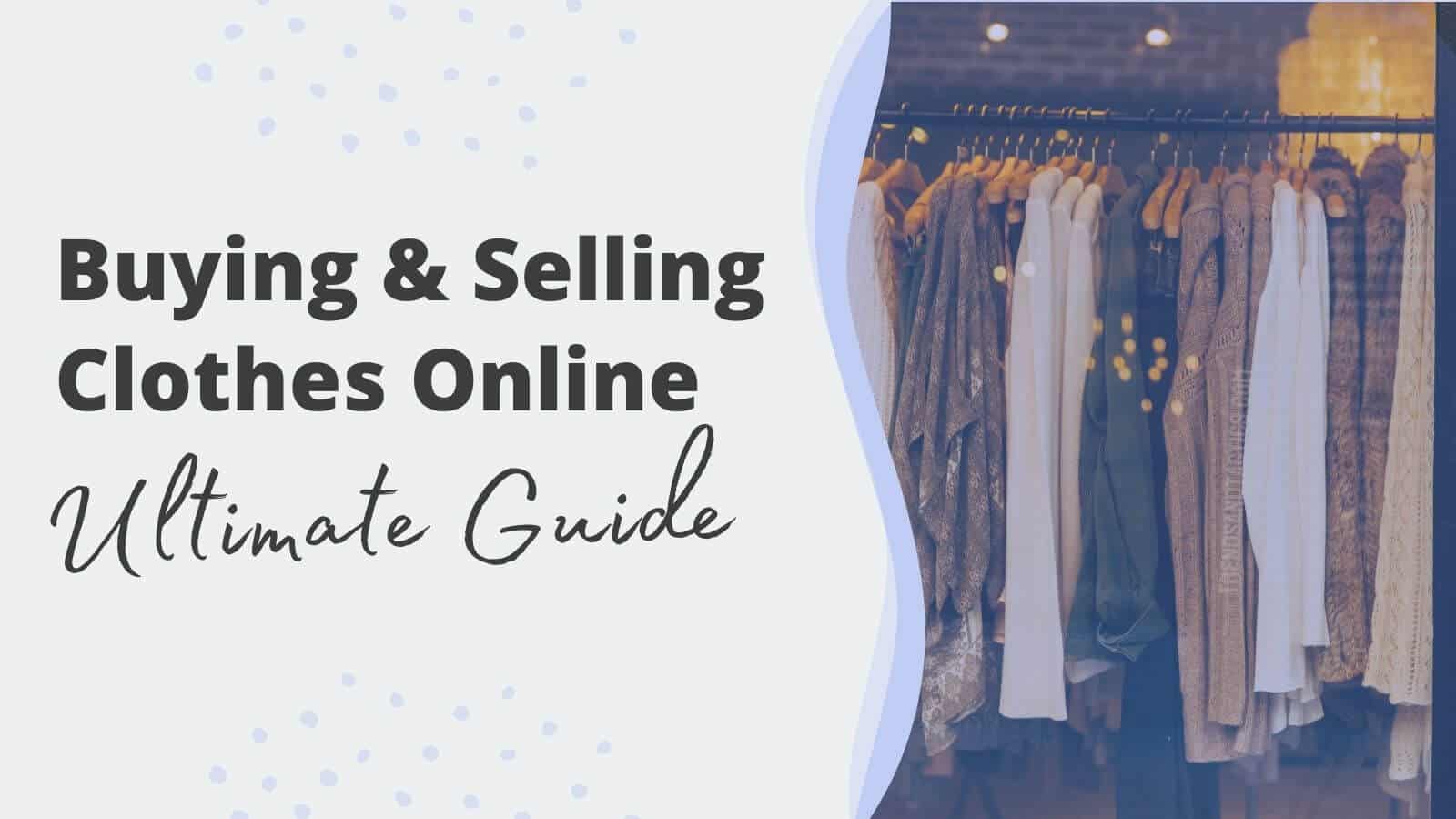There’s never been a better time to learn how to buy and sell clothes for profit.
Not only that, selling online generates bigger payouts than selling locally since you’re tapping into massive online markets.
With today’s technology and the right tactics, payouts are 3x, 5x or even 10x more than what consignment stores will give you.
Some of the clothing sales happening online are truly unbelievable, so don’t miss out. It’s no wonder clothing is one the top items to resell among power sellers online.
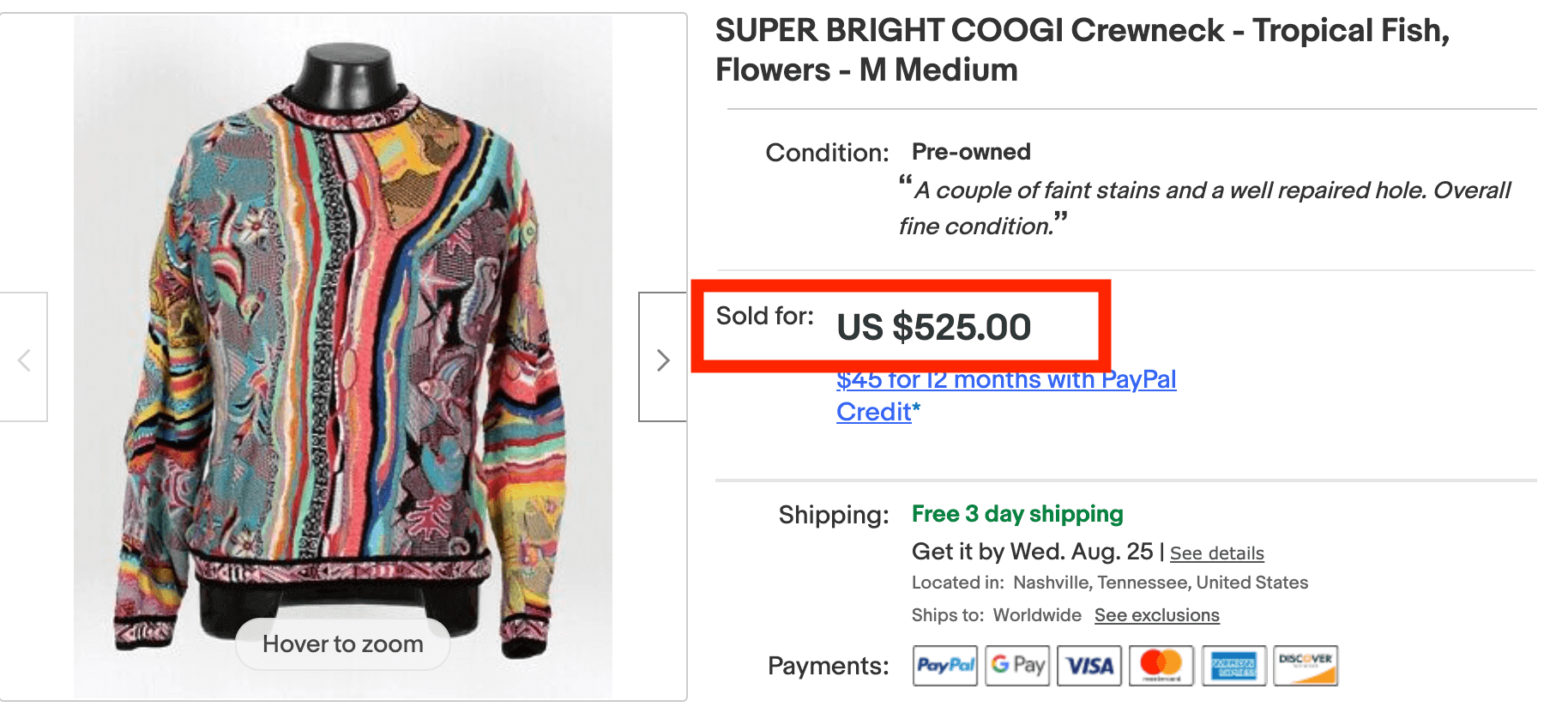
Having sold thousands of dollars of clothing online, I’ll share my best tips and tactics so you can sell clothes online as quickly as possible while maximizing profit!
Which Clothes are Worth Buying and Selling for Profit?
Determining which clothes are worth selling comes down to 3 main factors.
Focus on selling items with at least 2 factors if you are want a decent payout, but get all 3 and it means a big payday!
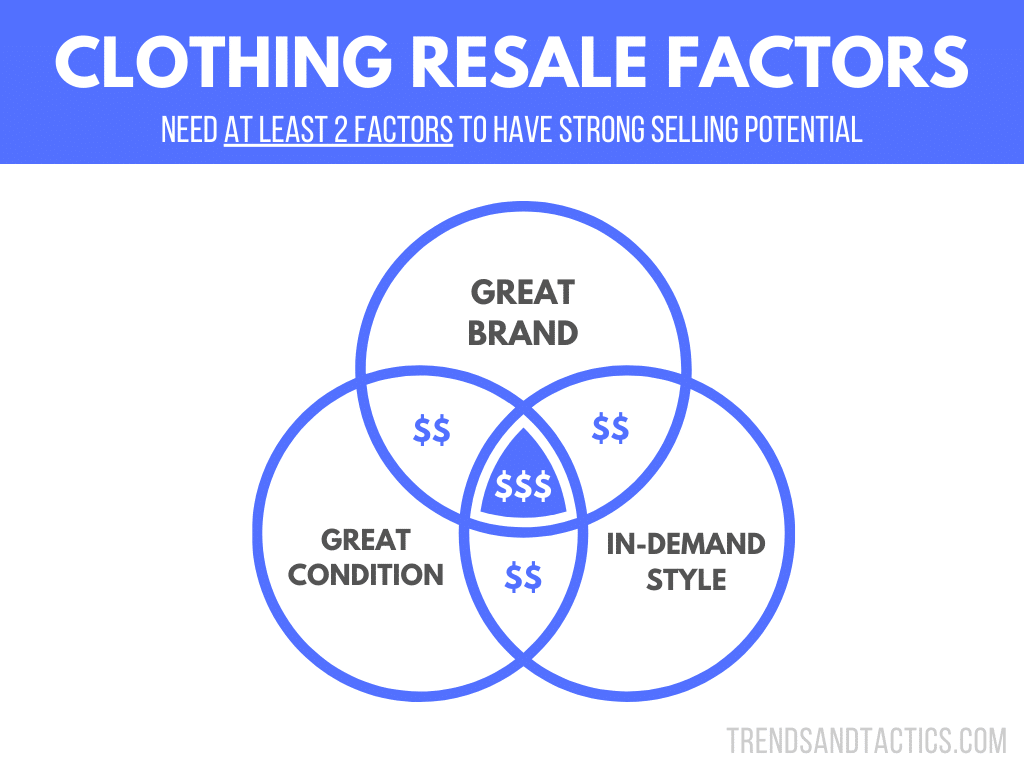
Once you have a rough idea if it’s worth selling, it’s time to check the specific market value.
To do this, look up your item on the marketplace of your choice, and check sold listings to get a sense of market value (eBay visual below).
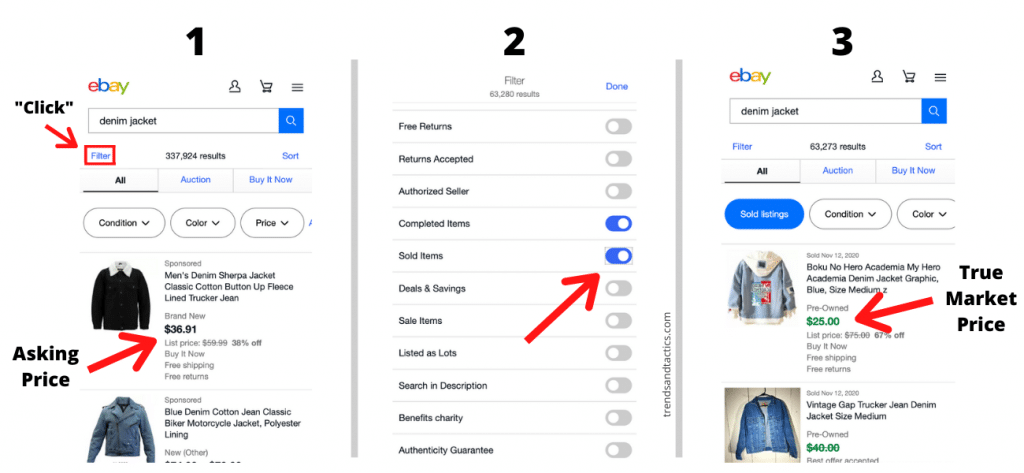
Sold listings reveal prices people actually pay for an item, as opposed to what sellers think customers should pay.
The difference is critical since sellers can technically price items for any amount, the sold listings will provide truest market value.
As you scrolled through sold listings you probably noticed a range of final prices. Condition is the underlying variable when it comes to how to sell clothes online effectively, and must be taken into account when estimating value.
It may come as a surprise, but flawed items can still fetch big profits, and is a popular way people make money on eBay.
To quickly gauge condition use the concept of discount rates. If something is like new, the price sits at the highest end of the spectrum. From there, reduce price by 10-15% per condition grade (see below):
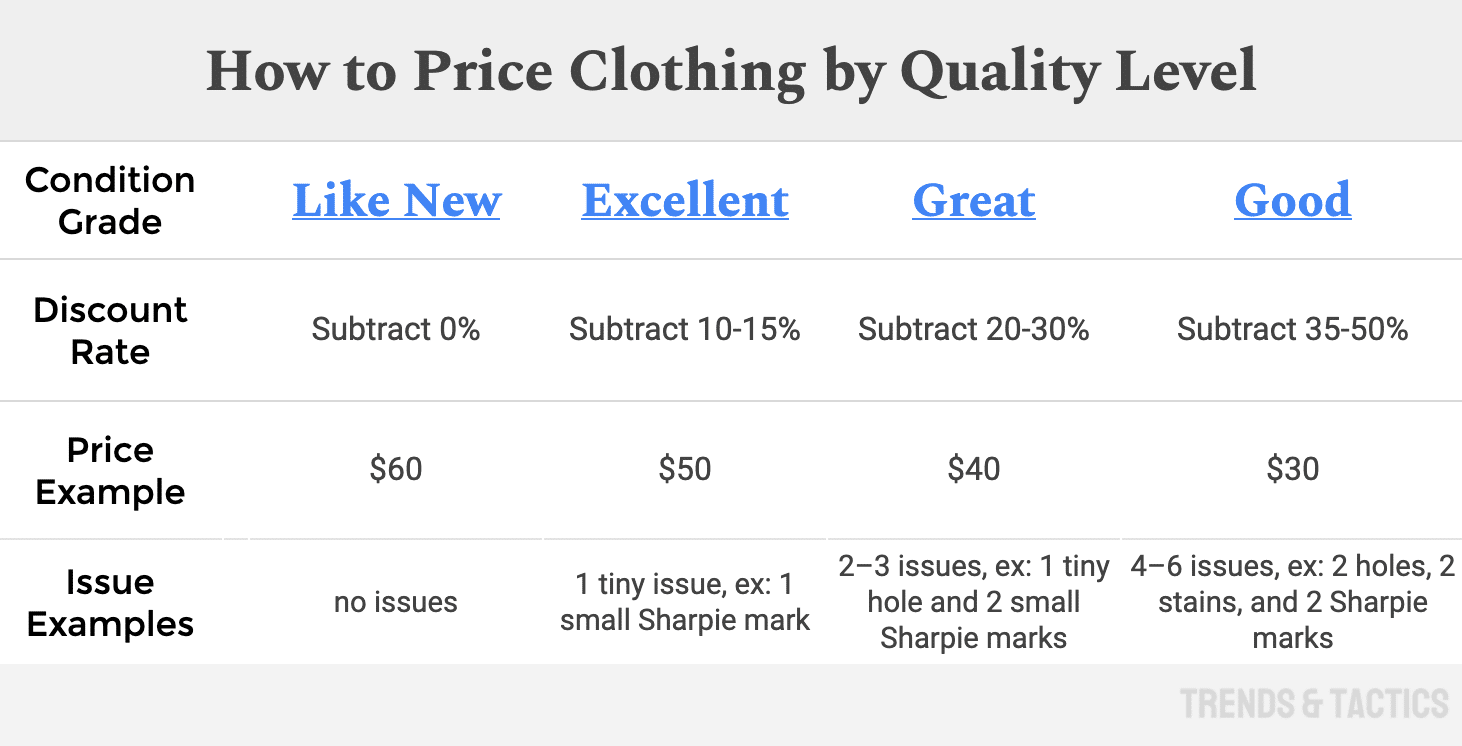
With a quick condition estimate in mind, you should now be able to accurately predict clothing values. At this point you can sort through your clothes and determine everything worth selling.
Quick Touch Ups & Prep Work
You might want to skip this step, but trust me spending a few extra minutes on prep will increase your profits significantly.
To be successful, it’s best to stick with the basics. If you happen to be a talented tailor, by all means patch up loose stitches and holes. For the rest of us, a washing machine and lint roller goes a long way.
Hopefully the clothing you’re selling is already in decent shape, and only needs a quick iron and a few passes with the lint roller.
At this stage it’s critical to remember the 80/20 rule, meaning focus on prep work with the greatest impact.
Best Clothing Touch Up Tips:
- Using a small dab of detergent on tough spot and scrubbing it out
- Scrubbing a Tide-to-Go pen on tough spots
- Using a lint roller or tape to remove loose hair/fur
- Throwing clothes in the washing machine
If you want this to become more of a second job, these tips will save you a tremendous amount of time.
Great Photos Make Clothing Pop
Poor quality photos will tank your profit potential quicker than anything. Don’t believe me, look at this example and see for yourself.

Would you, or anyone you know pay $30 for the item on the left? Of course not. Funny enough, the only difference is photo quality… the item didn’t change, and yet profit potential did.
Focus on these elements for excellent photos:
- Great lighting (preferably natural sunlight)
- Uncluttered background, such as hardwood floors, clean carpet, white or black backdrop, or a brick wall
- Neatly arrange clothing
- Photograph all sides of clothing, so there’s no surprises for buyers
While tempting to overlook, clothing flaws should be photographed as well. If not, the buyer will inevitably notice, initiate a refund, and leave a negative review.
Be transparent and upfront about clothing issues and you’ll save yourself time and headache in the long run.
Use Keywords to Boost Visibility
To maximize your profit potential, boosting search visibility is critical. Luckily we have a lot of control over this functionality with keywords, which makes it a key element when it comes to how to sell clothes online effectively.
Using keywords in your listing drives significantly more views to your clothes, since ecommerce platforms are essentially search engines.
If we include additional modifiers in the listing title, we create more avenues for buyers to find it.
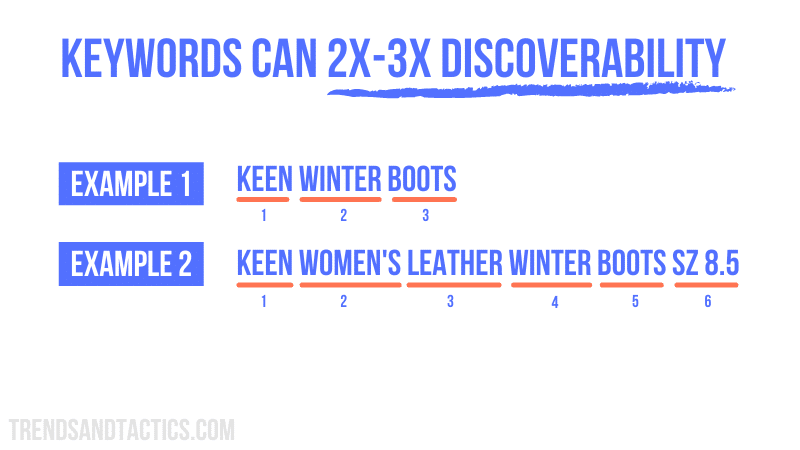
For example, if I’m selling a jacket let’s see a comparison between effective and ineffective modifier usage.
Example 1: Patagonia Blue Jacket
Example 2: Patagonia Mens Nano Puff Navy Blue Jacket Large Excellent
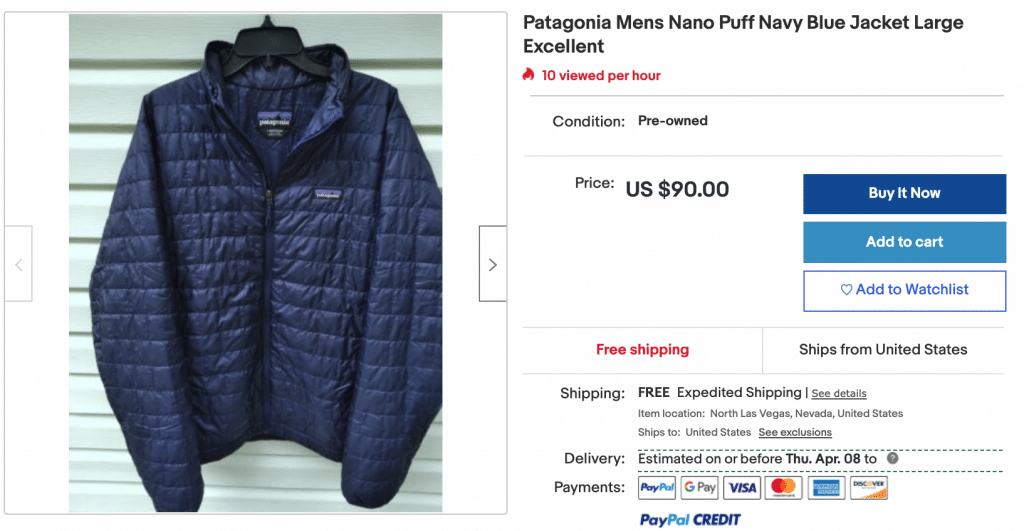
Immediately we can see how descriptive the 2nd example is, which not only helps customers better understand the product but also enables your listing to surface for different searches that the un-optimized wouldn’t (1st example).
If a buyer searches the phrases below, only the 2nd example would appear in the search results.
- “Patagonia puff jacket” (6,600 monthly searches)
- “nano large jacket” (320 monthly searches)
- “navy blue jacket” (6,600 monthly searches)
The bottom line, adding more relevant keywords puts your clothes in front of more buyers.
Include Sizing Details for Better Clarity
Will it fit?
What if it’s too tight?
These are common questions people experience when buying clothing online.
Remove the guesswork for buyers by including these details, and watch your sales grow.
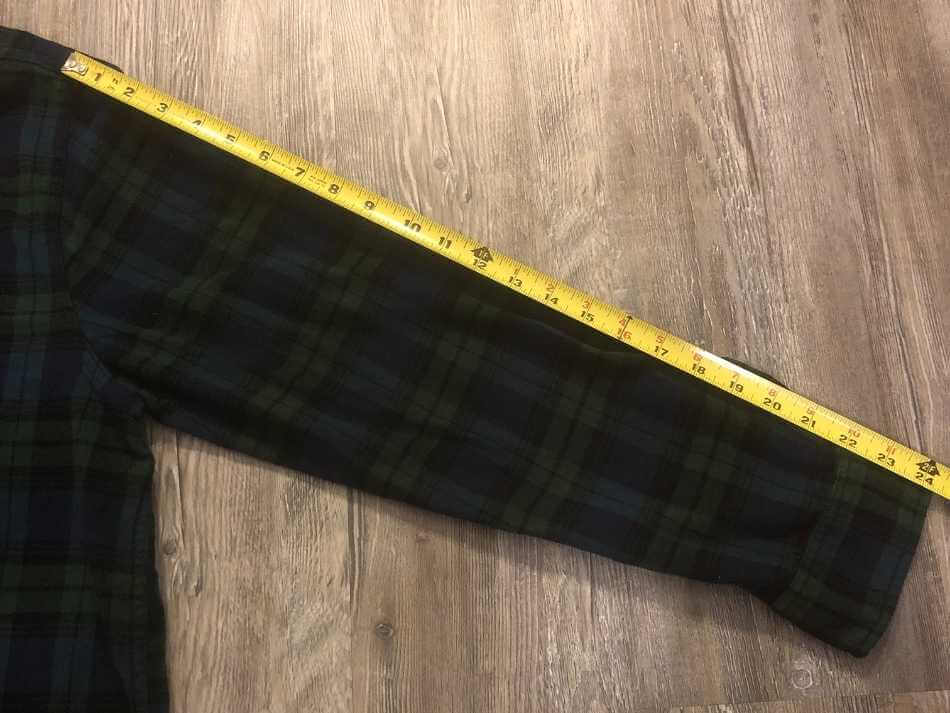
We recommend these key measurements:
- Several length measurements, examples: top of garment to bottom, arm length, inseam
- Several width measurements, examples: collar width, pit to pit width, waistline
- Size if labeled
- Material details
Basic measurements will cover 99% of buyers, although once in a while customers will ask for more minuscule details.
Sellers who include basic clothing dimensions also appear more professional, which instills trust in potential buyers.
Provide Excellent Customer Service
Great customer service is a game changer. Not only will sales go up, you’ll quickly establish yourself in the market as a trustworthy and professional seller.
Some sellers completely ignore questions from customers and consistently ship products late. This leads to lost opportunities and lost profit.
If a seller is dragging their feet on packing and shipping, buyers will cancel the order. Same goes for buyer messages. Oftentimes returning a message is all that stands between you and a purchase.
Whether you want to make extra spending money or go so far as to get rich selling clothes online, customer service is a must.
Top Tactics for Excellent Customer Service:
- Send out packages on time, or even early
- Promptly answer customer questions
- Properly package clothing and double check it’s 100% sealed so water and dirt can’t get in
- Include a thank you note
9 Best Sites to Sell Clothes Online
1. Ebay – the original selling platform
Ebay is the older kid on the block, meaning its marketplace is one of the most established and trusted.
Touting more than 2 million transactions each day, Ebay store owners sell anything from broken laser pointers to rare classic cars, and everything in between.
According to Ebay, men and women’s fashion items are among the most popular products on the site.
Sellers have a host of customizations available during the selling process including different pricing strategies (auction vs buy-now), a buyer offer system, and advanced shipping preferences.
Ebay is great for someone interested in a straightforward selling platform, with potential to sell more than just clothing.
Fees: fees ring in around 10%, although sellers have several opportunities to lower fees further by offering fast n free shipping and by signing up for a Ebay store which brings fees to around 8%
2. Depop – the social centric selling platform
Depop is a social centric fashion marketplace that broke onto the scene in 2011. With a similar look and feel to Instagram, success depends on building a follower base of people interested in your style and clothes.
Despite approaching ecommerce in a less traditional way, Depop boasts more than 13 million users, 90% of which are under 26 years old.
Quick user traction comes from the blurred line between social engagement and clothing purchases… meaning Depop married the addictive nature of social media with purchasing opportunities.
This is one of the more popular platforms used to make money as a teen, due to the social element.
Fees: Sellers pay a 10% fee on the total listing price (including shipping)
3. Thred Up – one and done selling platform
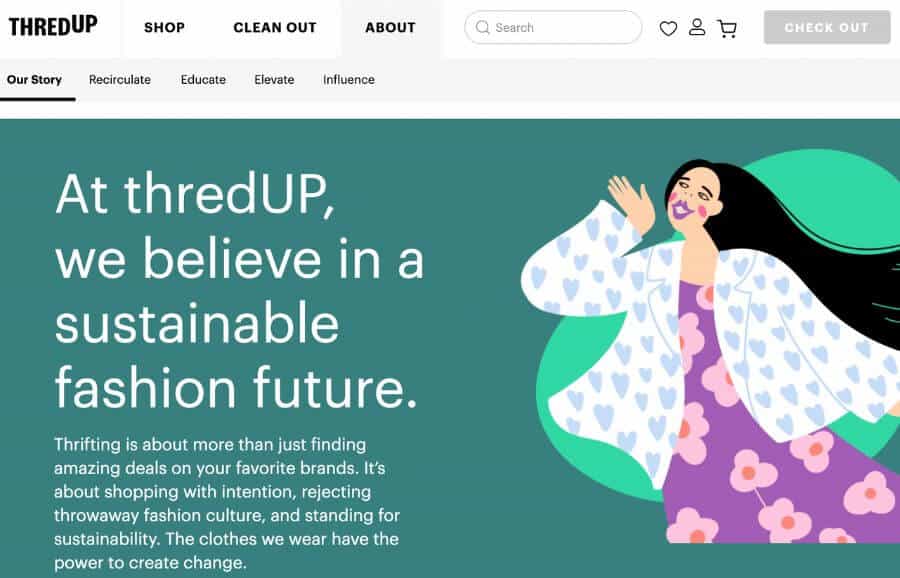
Thred Up brings consignment store convenience directly to you. When you’re ready to clean out your closet, request a free Clean Out Kit and start loading it up with your gently used clothing. Once filled, send it back to Thred Up HQ with the prepaid UPS label.
Contrary to consignment stores, Thred Up is less picky with clothing they accept, and instead offer a wider range of payouts.
It’s worth keeping in mind, this platform doesn’t accept men’s clothing, and receiving payouts can take a little longer than other selling apps.
To date Thred Up has processed over 100 million garments and displaced 888 million pounds of CO2 by preventing fashion waste.
Fees: The payout percentage ranges from 3% to 80%, based on selling price (higher priced items pay less in fees).
4. Thrift + – make a difference in communities selling platform
Thrift + was created with a charitable mission in mind “helping charities to serve the next generation of donors and shoppers.”
The goal is less to do with maximizing profit and more to do with making a difference for others. 33% of every sale goes to the fund of your choice, through PayPal’s Giving Fund. If your clothing isn’t a good fit for online sales it’s donated to a local charity.
To get started, request a ThriftBag and load it up with garments you’re ready to part with and the company does the rest. Payouts come in the form of Thrift+ gift cards, with an average value of $20.
Fees: Seller fees come in at ~30%
5. Vinted – fee slashing seller platform (0% seller fees)
With over 34 million members, Vinted is a re-imagined Ebay with a few unique twists.
First and foremost there are no seller fees, instead customers pay a small buyer protection fee of 5% + $0.70. In return, customers receive advanced fraud protection and access to a dedicated support team.
Swapping items is also possible on Vinted. If a seller is open to a swap in addition to traditional payment types, a swap symbol appears on the listing.
Finally, if sales start slowing down you can “bump” your listings for additional visibility for a small fee.
Fees: There are no sellers fees, the full sales price goes straight to your Vinted balance.
6. Mercari – minimalist rapid selling platform
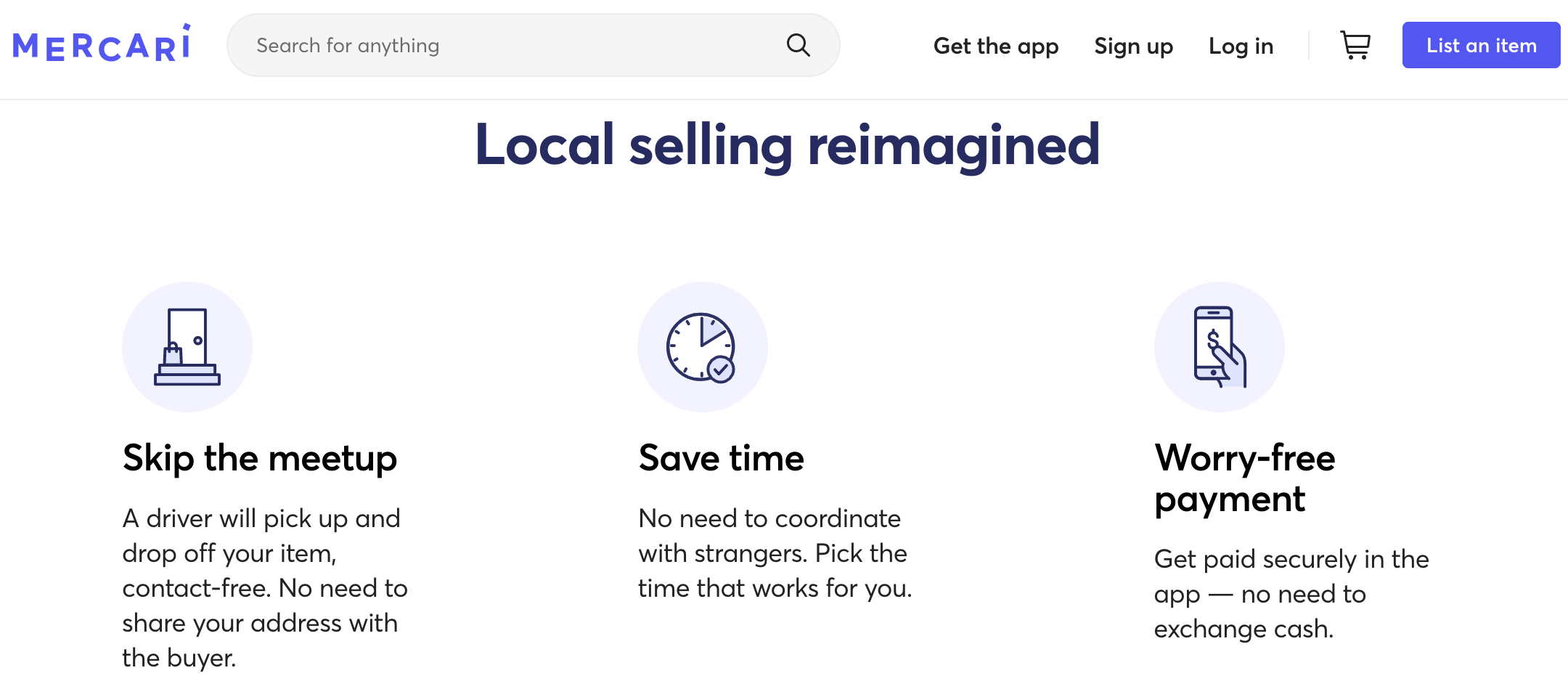
Mercari aka “The Selling App” makes selling clothing a breeze. How? By keeping listings short and sweet, and focused on need-to-know information. To get started, snap a few photos, add a description, and set your price.
With over 50 million downloads clearly there’s something to this minimalistic style of buying and selling. Unlike some ecommerce platforms, Mercari sellers can sell more than just clothing, which is great if you’re thinking about diversifying into other categories.
Fees: Mercari charges sellers 10% on sales
7. Poshmark – largest social centric fashion platform
Poshmark is a social driven selling platform. With over 60 million community members, it’s like instagram for your closet. Success depends on liking and following other Posher’s closets and even attending Posh Parties, which are real-time virtual hangouts to share and exchange items.
Interested in selling more high end stuff? Poshmark makes it easy to sell luxury clothing and accessories, with their complementary authentication process for items over $500.
When you’re ready to sell, the process couldn’t be easier, just snap a few photos, describe the item, and choose your price.
Oftentimes sellers compare Poshmark, eBay, and Mercari to each other to determine the best platform for selling. The truth is they each have their strengths and it depends on the sellers goals.
Fees: For sales under $15 Poshmark charges a flat fee of $2.95. For sales over $15, the seller fee is 20%
8. ASOS Marketplace – extra bells and whistles selling platform
ASOS was designed exclusively for independent brands and vintage clothing fanatics. If you fall into one of those categories, sellers create what are called boutiques which act as your digital storefront.
Unlike other platforms, sellers receive a dedicated account manager to support business growth. Additional perks include potential features in ASOS partnered editorials and social platforms.
If your wardrobe doubles as a time machine and is overflowing with vintage clothing, ASOS delivers a targeted audience of vintage hungry buyers.
Fees: Boutique fees are $26/month with 20% commission on sales.
9. Etsy – the crafters and hobbyists selling platform
You may know Etsy as the Ebay for crafters, but with 2.5 million active sellers it’s much more than that. Sellers can display almost any kind of clothing, however vintage tends to outsell other styles.
One of Etys’ major perks comes in the form of steep shipping discounts, which boosts your profit potential. Setting up a beautiful storefront takes a few minutes and doesn’t cost a thing. Listings is similar to other platforms following a minimalistic approach.
Fees: 5% transaction fee + 3% payment processing fee
Best Tips for Selling Clothing Online Successfully
Cross List Products on Multiple Platforms
Still unsure which ecommerce platform to use? Luckily you can pick more than one, and this actually becomes an advantage to how to buy and sell clothes for profit.
Listing the same product across multiple platforms is called cross listing and is common practice among seasoned sellers.
Cross listing multiplies visibility of your clothing since you’re tapping into multiple user bases as opposed to 1.
Once sold, simply remove the item from other platforms, and voilà you just doubled, tripled, or quadrupled your selling power.
To make cross listing a breeze check out Vendoo
Consider Lotting Out Low End Clothes
Knowing what to do with cheaper clothing can be a challenge. It’s probably tempting to donate it or even throw it out. A cool tactic to easily turn these clothes into cash is called “lotting”, where you put several pieces of clothing into a bundle aka “lot”.
It’s difficult to sell a run of the mill average t-shirt. At best you could get a few dollars.
However, if you bundle 10 average shirts into a lot it becomes more marketable and could land $25-$30.
By packaging clothes this way, the selling angle changes and becomes interesting to parents with many kids, crafters, or even resellers interested in flipping the items individually.
Regardless there’s a massive market for selling lots, check out these examples:
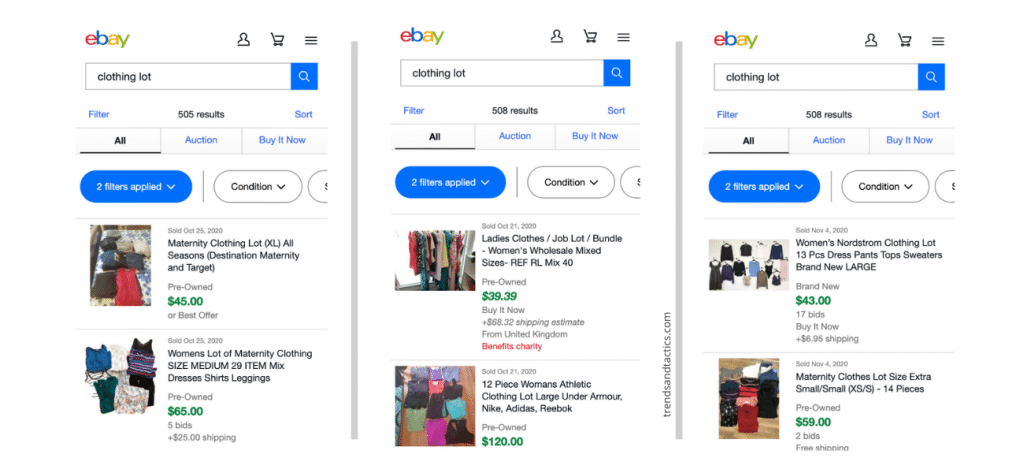
Have questions or comments? We would love to hear from you in the comments section below!
How Much Profit Can You Make From Selling Clothes?
Selling clothes online is one of the easiest ways to make money from an outdated wardrobe.
Getting rid of secondhand clothes offers multiple benefits – namely, you can declutter your closet, make some extra money, and help minimize waste that goes into landfills from sending your old clothes into the trash.
To sell clothes online, you need to start by finding the right platform. ThredUp is one of the best. You can order a cleanout kit for free, load it with your old clothes, and ship it off. They’ll take care of the rest.
You can also sell old clothes online by visiting websites like Poshmark, eBay, Depop, Facebook Marketplace, and Tradesy.
Before choosing, you’ll want to consider a few factors. For example, do you want to price and list the clothes yourself – or let someone else take care of those details?
Do you want to be paid a bulk price for your clothes or get paid for each individual item (tip – the latter option is best if you have lots of high-value threads!).
Also, how quickly do you need to get rid of the items? If your goal is to offload as many clothes as quickly as possible, then you’ll want to choose an option that gives you more control, like Facebook Marketplace, over one that consigns the clothes for you (like ThredUp).
John-Paul Cody has been an avid online seller for years, across platforms including eBay, Mercari, Craigslist, and more. He has a Bachelor's Degree in Economics from UNC Chapel Hill, and works in data analytics and marketing.
